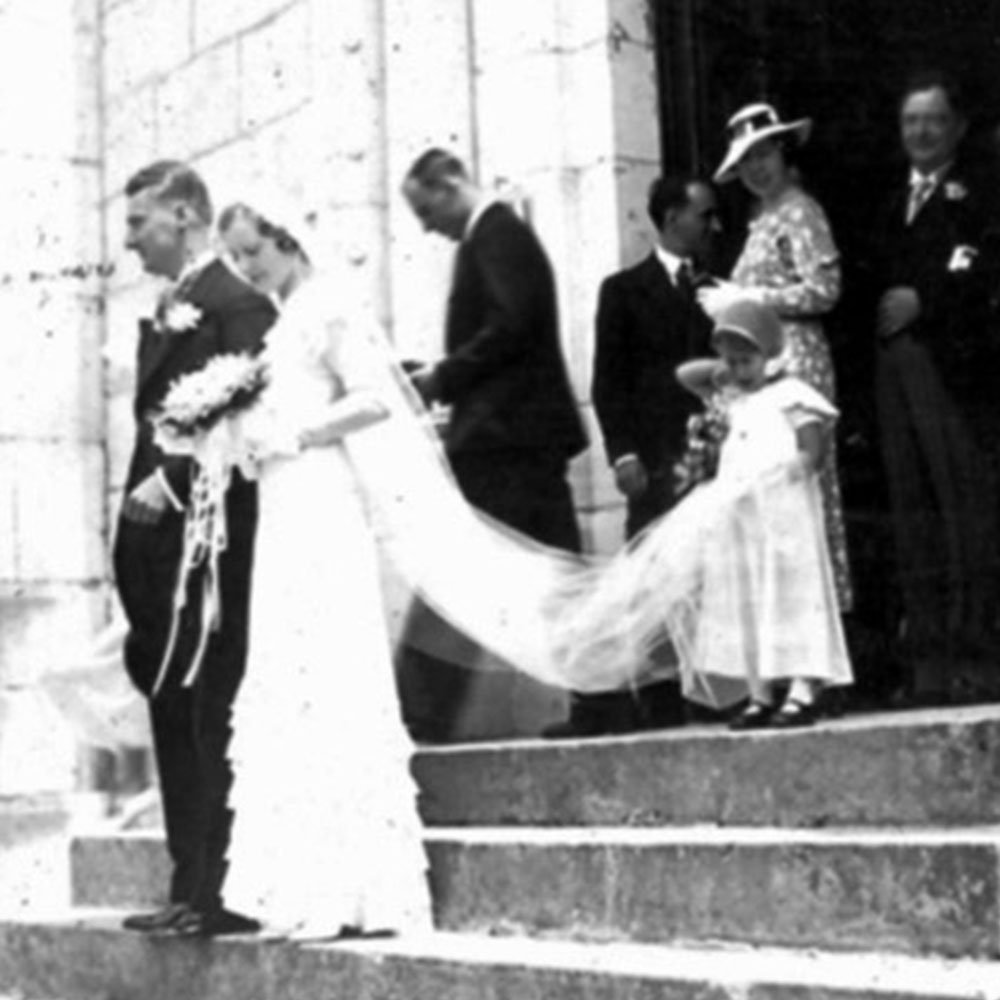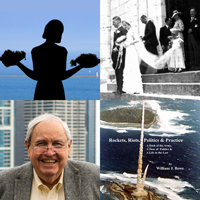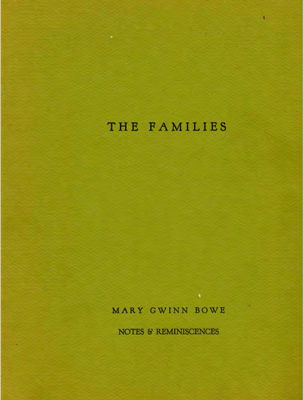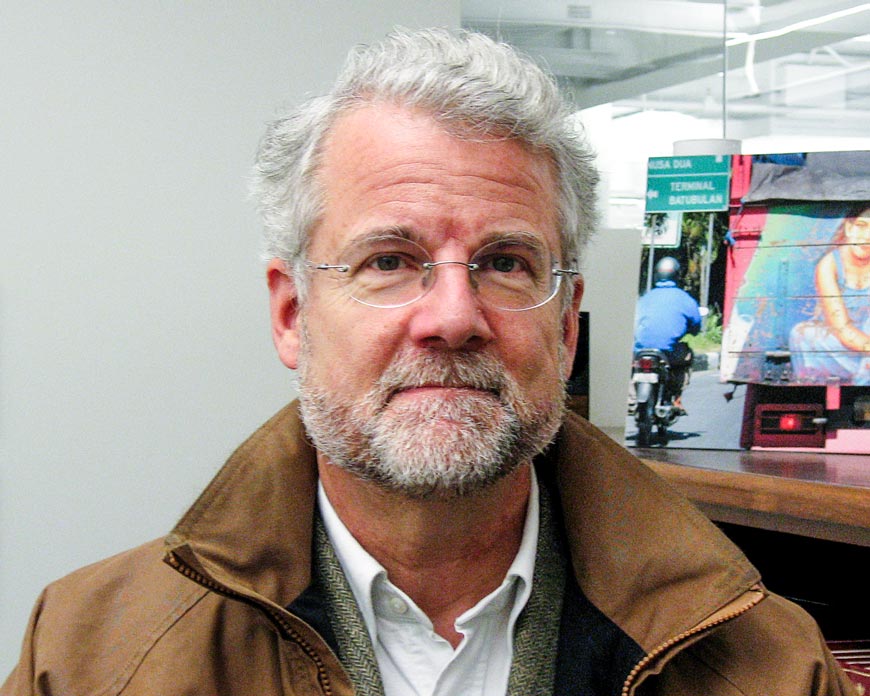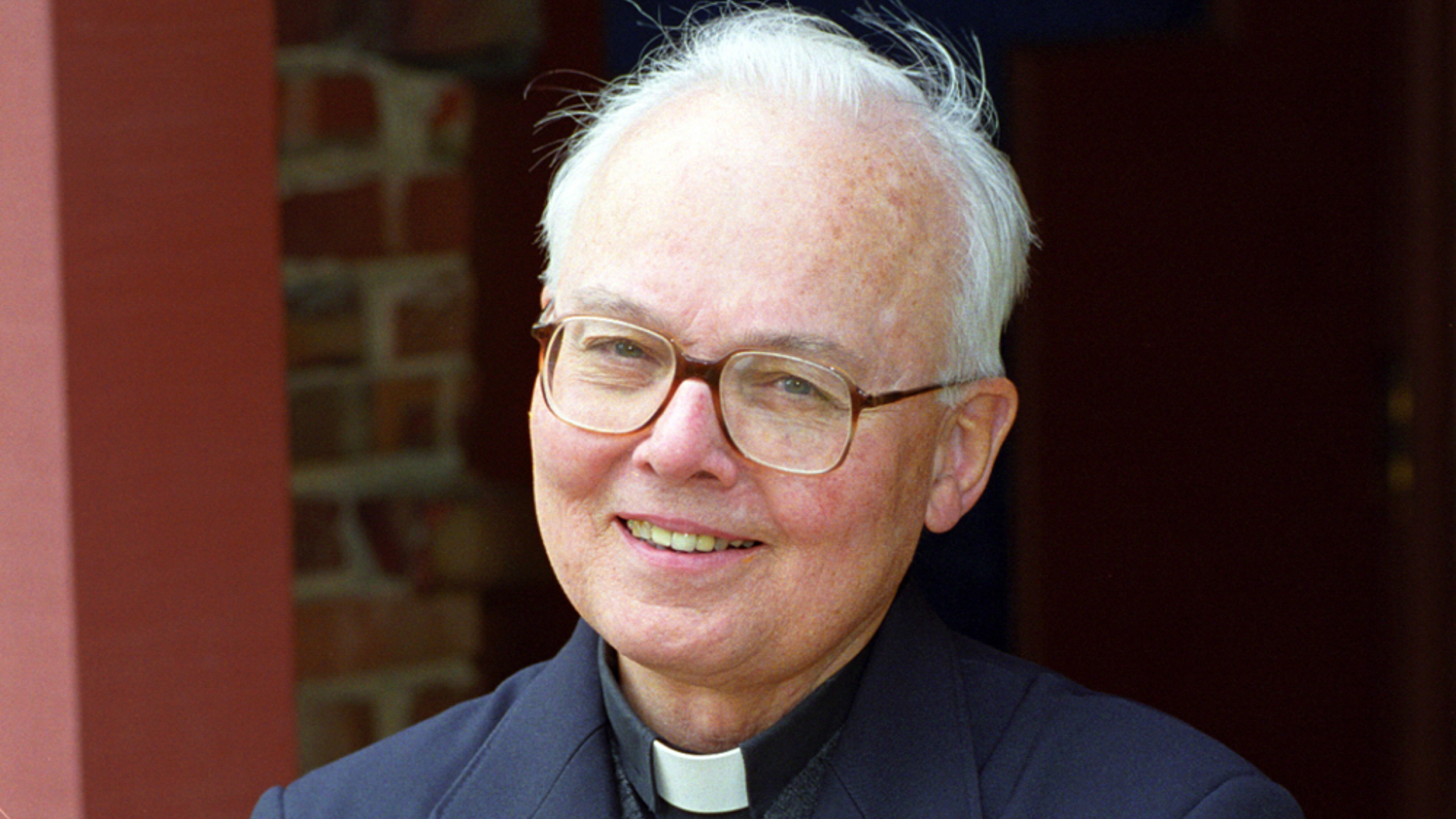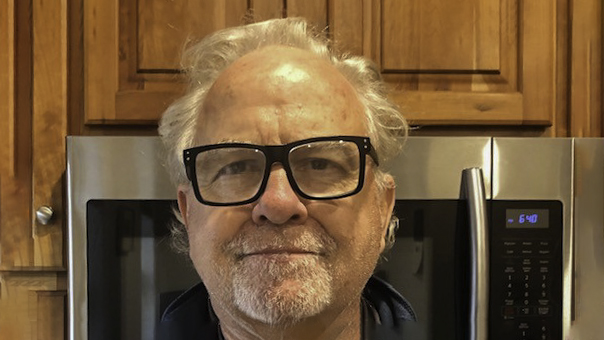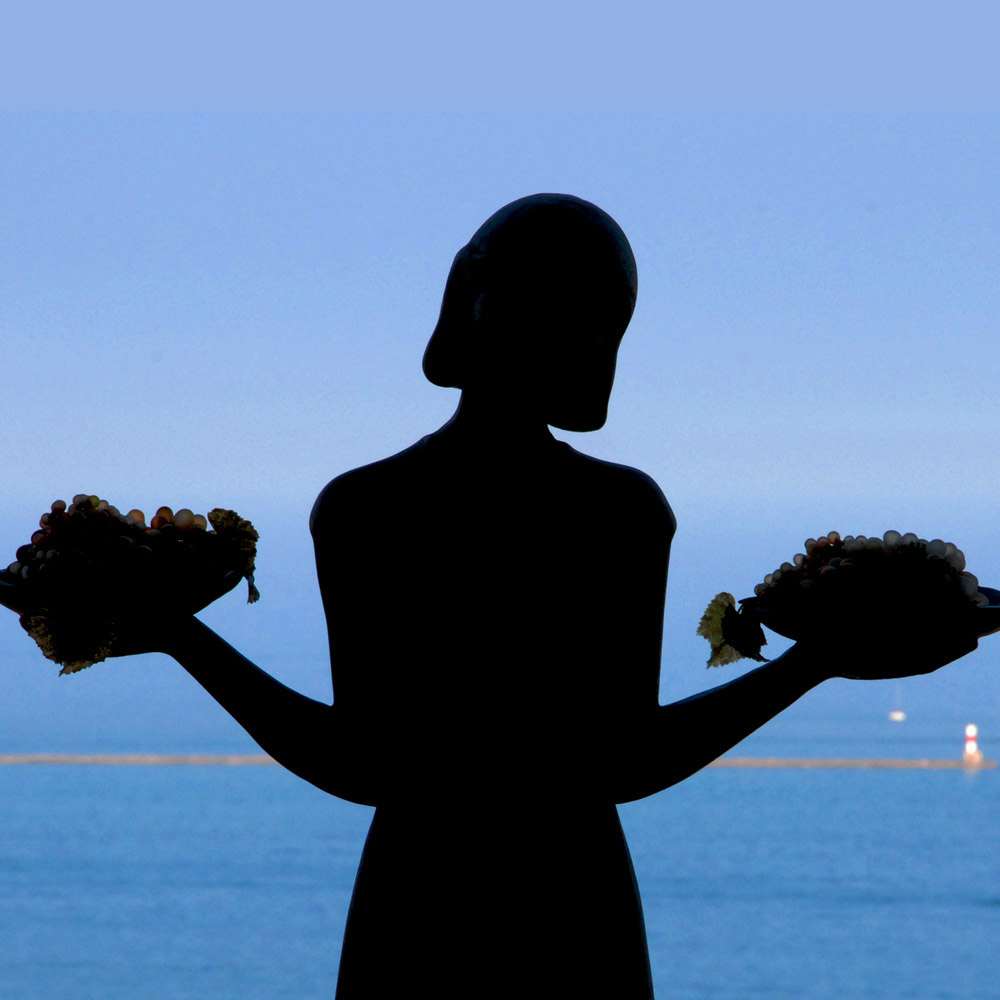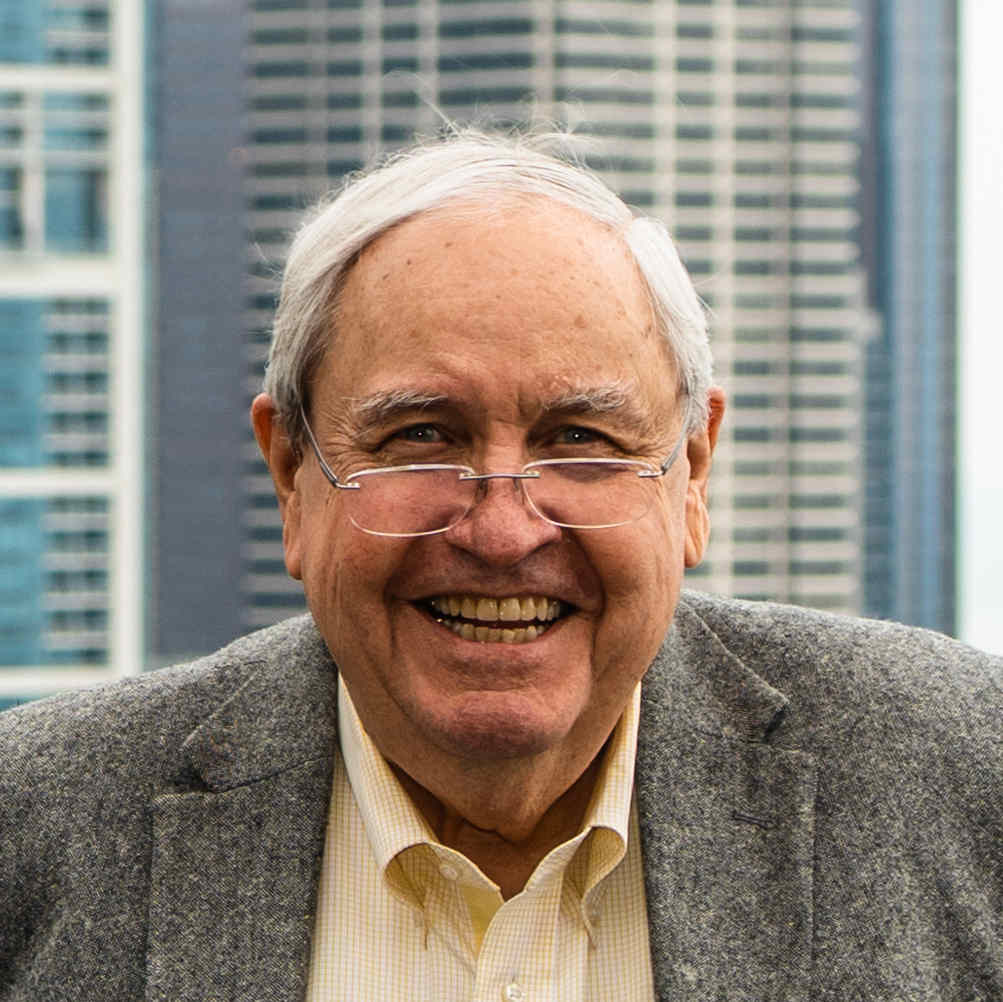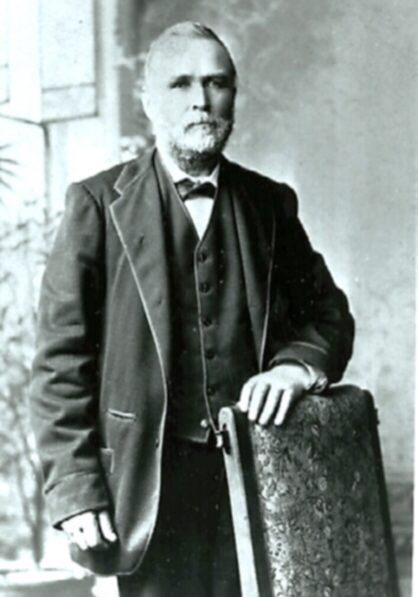
b. 1822 Curraghadooey, near Claremorris, County Mayo, Ireland
d. 1890 Momence, Kankakee County, Illinois
Families Related to the Canavans
Bowe, Cain, Canavan, Casey, Danielak, De Rosa, Dunn, Dwyer, Freborg, Gomez, Grubert, Gwinn, Hanley, Hart, Hect, Heffron, Lecour, Lynch, MacPherson, Meyer, Parish, Pleil, Reyes, Roche, Romano, Skura, Sundstrom, Tack, Terpstra, Thompson, Truskey, Turner, Walters, Wernstedt and Williams
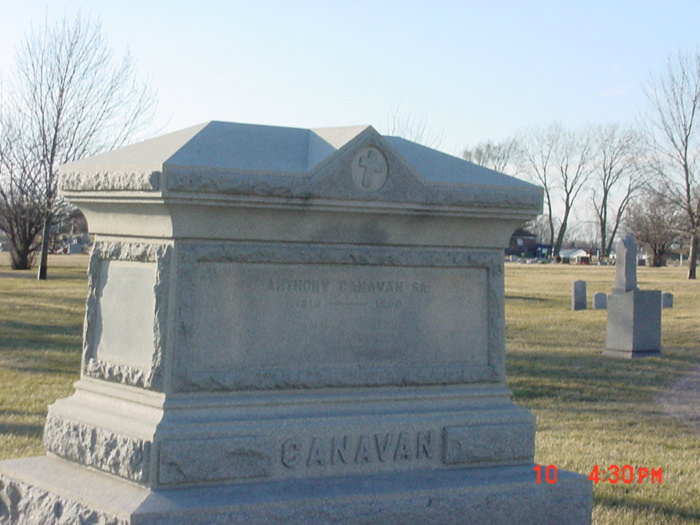
Editor’s Note: The following obituary appeared in the 1890 Kankakee County Portrait and Biographical Record. In spite of being a record contemporaneous with his death, later research pointed to Anthony Canavan’s father, namesake Anthony Canavan, and his mother, Catherine Kirby, had nine children, not 11 as the Kankakee Biographical Record had it. Also, the better view seems to be that Anthony Canavan and Ann Hughes had 13 children, not 11. Augusta and Edward seem to have been misplaced along the way by both Record and my mother in her 1970 book The Families.
Anthony Canavan, Sr. was a native of Ireland, his birth occurring in County Mayo in 1822. He was one o f a family of eleven children born to Anthony and Catherine Kirby (“Kittie”) Canavan. The boyhood days of our subject were passed in his native land, where he received the advantages of a fine education. He resolve to seek his fortune in America while still a youth, and in pursuing that plan bade adieu to the friends and scenes of his youth, and in 1840 took passage on a sailing-vessel, his destination being Philadelphia. For nine weeks and three days he was upon the broad Atlantic, and upon his arrival in the Quaker City he obtained employment in a wholesale grocery. With one firm he remained for nine years, and was ever faithful to their interests.
In 1849, Mr. Canavan concluded he would leave mercantile life and devote himself to agriculture. Coming to Illinois, he decided to locate in Kankakee County, and worked a rented farm in Gainer Township. After living upon this farm for four years, Mr. Canavan purchased one hundred and sixty acres of land in Sumner Township, situated in section 12. This property he improved and there carried on general farming and stock-raising. He was possessed of the necessary attributes for success–industry and economy– and in addition exercised wise judgment in the investment of his money. By degrees he added to his original purchase of adjoining property, until his possessions amounted to four hundred and eighty-two and a half acres of valuable land.
In 1841, Mr. Canavan was married to Miss Ann Hughes, who is a daughter of James and Mary (Carney) Hughes. Mrs. Canavan was born in 1822, and is living, still in the enjoyment of good health, although now seventy years of age. Eleven children were born of this union, ten of whom are still living. The four eldest children were born in Ireland, and are as follows: James Canavan, John Canavan, Anthony (Tony) Canavan and Mary Canavan (McNulty). The others, who were born in the United States, are Austin Canavan, Patrick Canavan, Augusta Canavan, Thomas Canavan (who died in infancy) and a second Thomas Canavan, all of whom were born in Philadelphia; Catherine (Cate) Collette Canavan, Edward Canavan and Ellen (Nellie) Francis Canavan, who were born in Sumner Township. The latter is the only one still residing under the parental roof.
Mr. Canavan served his township in various offices requiring ability and fidelity, among which we mention Treasurer, which he held a number of years, Supervisor about twelve years, Trustee, Assessor and Collector. He was a strong politician, and was ever interested in the success of his party, being a staunch Democrat. Mr. Canavan lived and died in the faith of the Catholic Church. He was called to his final rest on the 6th of March, 1890, and his remains lie buried in the Sumner Cemetery.
His family have erected a beautiful monument to mark his last resting-place. As one of the early pioneers he deserves special notice, for he assisted materially in opening up and making habitable this now prosperous county. He struggled manfully through the hardships and privations common to a new and sparsely settled region and well deserved the prosperity which he enjoyed during his last years.
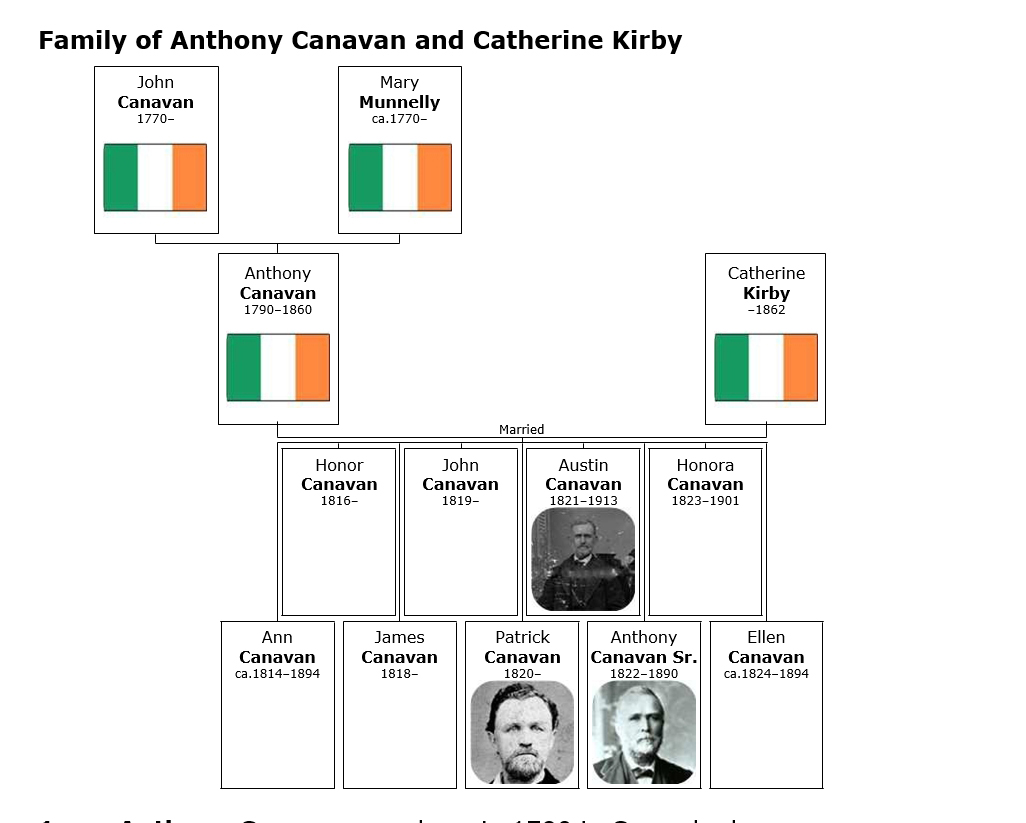
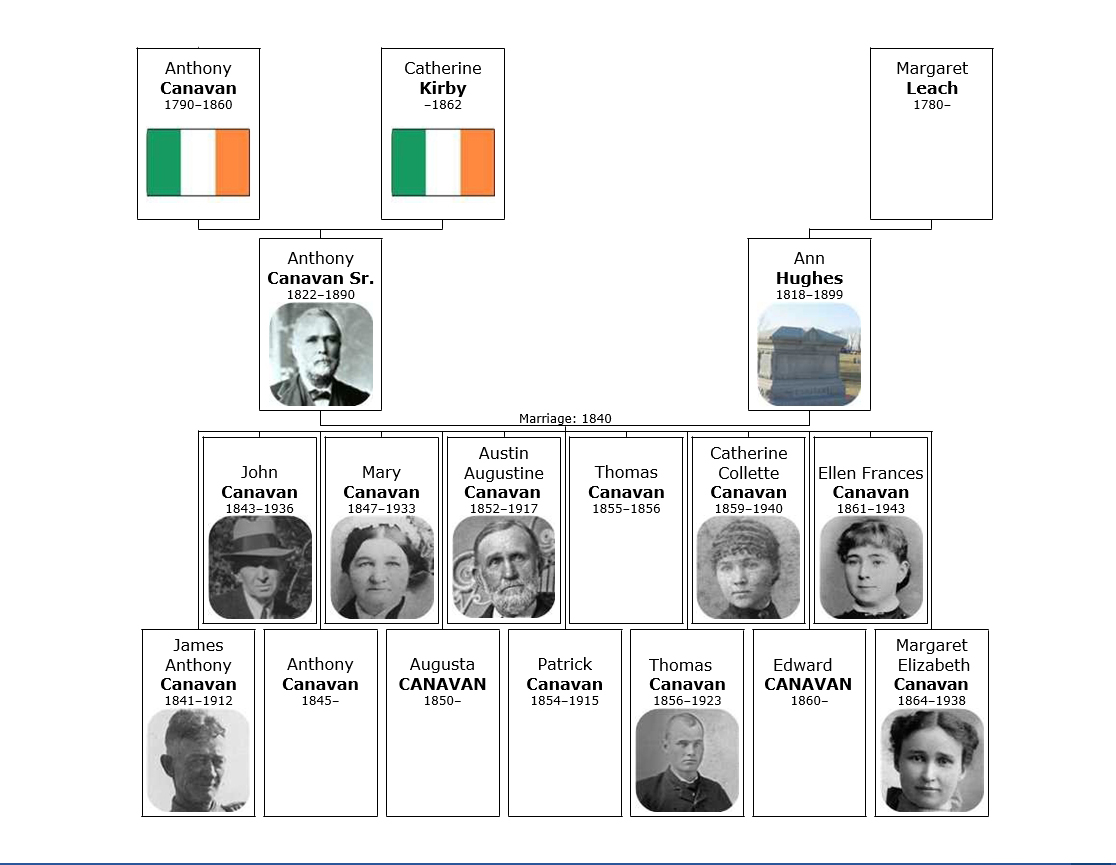
The Canavan Family
From Mary Gwinn Bowe’s The Families
Leaving County Mayo in Ireland for Illinois and Iowa
Anthony Canavan, born in County Mayo in 1822, came with his family during the famine. He was nineteen and Ann Hughes was eighteen when they were married in 1841. For the six weeks crossing to Philadelphia in a sailboat, they brought their own provisions and cooked their meals on deck. Their boys, Jim [James Anthony Canavan], John [Canavan], Tony [Anthony Canavan] and Patrick [Canavan], they brought with them. Mary [Canavan], the baby, too small for the rigors of such a trip, w a s left in Ireland with the grandparents. It was a long and rough crossing, and during one storm Jim’s arm was broken when the main mast broke and part of it fell on his, and John lost the sight of one eye.
All suffered from ship’s fever and when they docked the father had typhoid. He was taken off in an ambulance to the Quakers’ William Penn Hospital. When he died many years later, he left them a bequest of $5,000 for their kindness to immigrants. At that time many Irish landed in Philadelphia, but for the most part they were very poor and the Canavans were no exception. But four active boys, selling newspapers and running errands could bring in enough to buy food. The mother with small children stayed at home and took in sewing.
Once out of the hospital, the father found a position with a wholesale grocery firm owned by a Quaker and worked there as a trusted, senior employee for the nine years they spent near Fourth and Walnut Streets and the Church of Saint Augustine. This was the height of the “Know Nothing Movement.” There were many Anti-Catholic disturbances and the church was burned down. They named their next child Austin Augustine. They had managed to save $1200.
Anthony had a brother, Austin, who had immigrated some years earlier and had settled in Momence, Illinois. He had married Mary Ann Hathaway, a wealthy widow with a large farm. She used to say she couldn’t catch cold because she was wearing her balsam. She became a convert both to Catholicism and to Ireland. Uncle Austin made frequent sailboat crossings to the United Kingdom and to Ireland and became known as quite a gambler. He wrote his brother to come out to Illinois, “the virgin prairie where you can get a homestead and raise a family away from the crowded city.”
So in the 1850’s with all their belongings they came West in a freight car as far as Kankakee, and then by wagon to Momence. They stayed with Austin for nearly a year trying to make up their minds where to settle. Finally, they bought 640 acres in Sumner for $1 .00 an acre. It was seven miles from the railroad, and not very good land and must have required very hard work.
Now they wanted to have their little daughter brought over from Ireland. She came with the next travelers from their village. As an old lady, Aunt Mary said later she was unhappy in her new home. She met her brothers and sisters as strangers and because of her brogue, the other Americanized children called her “greenhorn”.
The farmhouse is still standing, but it is hard to see how such a large family could be raised in such a small space. But perhaps the older children had married and left before the younger ones were born. The older ones in Ireland must have been born in the 1840’s, but Catherine, Ellen and Margaret were born in Illinois in 1859, 1860 and 1861.
The sons born in this country went to college; those born in Ireland couldn’t be bothered with such nonsense. The boys went to Saint Viator’s College in Bourbonnais, while the girls attended first the convent in Kankakee and then the one in Michigan City, Indiana. The fears of their old Quaker friend were unfounded–they all went into wild Indian territory and were not scalped by the Illini.
About this time they had been breaking the prairie with oxen, but Anthony Canavan introduced other agricultural methods, and he was one of the first farms in that part of the state to raise cattle for market.
At the outbreak of the Civil War Uncle John joined the Union Army , not so much as a patriot as a mercenary. He and his team were hired by the army as the Quarter master Corps needed horses and drivers. However, he was taken prisoner in the South and was near death at one time in Anderson prison. When Uncle Gus, Aunt Em’s husband died, the farm ledgers were in the office of Bowe & Bowe and showed that the farmers had prospered. He had taken in $9,000 in the year 1861. This was a fortune then, and a mere twenty years after he had taken his family from stricken Ireland, he was able to send his children to college. Gus was a graduate of the Yale Law School, where he also was on the rowing team.
Anthony, Jr., or Tony, was not interested either in the land or further schooling. He was the first one to come West, five years before his parents and the rest of the family and was old enough to remember Ireland. Stirred by a deep desire to return and see friends, relatives and his birthplace, he felt that he had earned the trip back. As though by Providence when he collected the mail he. found a check of his father’s for $1,500, which was made out in his name. He saw no reason for not going to Ireland with this money. So he did go, spending about a year and bringing back many presents to his relatives. He told great stories about the new land and enjoyed the poteen.
In the dark days in Philadelphia he had been a strong staff to his mother, but he had grown old beyond his years and had found rural life too tedious for an Irish gentleman of his parts. He felt that he had worked and earned the money and it was up him. But the last twenty years of his mother’s life were spent mourning the lost lamb’s disappearance. He was last seen in the office of Uncle Gus, then a impecunious lawyer. He had returned from California, having gone there by boat from Ireland. He had found there some uncles and reported that one of them was a legislator there and had gone out around the Horn and ran the largest gambling casino in San Francisco.
When he called on his brother, he found him in his office with little business and wearing a shiny suit. He said this was not becoming to a lawyer, especially a graduate of Yale. He insisted on changing suits with him in the office and he departed never to be seen again. His mother saved all her egg money, $8,000, in the hope of Tony’s return.
Uncle James was apprenticed to Leon Euziere to learn the saddler’s trade. This included all kinds of leather work, making reins, saddles, boots and shoes. Leon was a businessman who had come from Switzerland and whose wife never learned English very well. As soon as James learned the trade, he moved away from home and took a lake steamer over to Saint Joseph, Michigan, where he married Ann Kingsley and eventually became post master.
John was better at farming and was a great help to his father. He married Ann Doyle who was from a farm in Saint John, Indiana. Her mother was a sister of Anthony Canavan, Senior.
Austin married Emma Valiquette of Chicago whose father owned tracts of land on the South Side. They had a good home and an interesting life, but no children; they used to invite the members of his family to come and stay as long as they liked.
Mary Canavan, the child with the unhappy accent, married Anthony McNulty, her first cousin. His mother, Ellen, was a sister of Anthony Canavan.
The next child, Patrick, went to Saint Joseph following his brother who was already in Michigan with a cobbler shop and saddlery business. Patrick married Elizabeth “Bird” Larkin and they had one child, Elizabeth, mother of the Hanleys.
Thomas Canavan always stayed on the farm and only moved into Kankakee toward the end of his life. He married Victoria Graveline, an accomplished musician, and they brought up her niece, Bernadette.
The last three girls of the family, Ellen, Margaret and Kate, looked after their father and mother. In 1882 Kate married William Wallace Parish of Momence, whose father had come out from New York State in 1830. Ellen, the next to leave, married John Bowe, the son of Moses Bowe of Peotone. Then there was not one left at home except Maggie. When she decided to marry in 1899, her mother was already poorly. Her wedding to Judge John Casey was in the Holy Name Cathedral in Chicago. In December, Ellen took her children down to the farm to stay with the ailing mother. The father, Anthony, had died in 1890. Ellie went with the widow to Judge Sawyer to verify her mother’s widow’s rights. After the mother died, Tom lived on at the farm with Victoria and Bernadette.
Moses Bowe had married Honora Hurley, who came from near the Lakes of Killarney. He had travelled alone from Wexford, an orphan at the age of eleven, when an uncle sent for him to come to the United States. He ran away and worked on the Erie Canal and later on the Illinois Central. He was very big and strong and is said to have had a fist fight with a cook who refused to wash his hands before getting their breakfast. He married Honora Hurley in Monee, which had a boarding house for the men who were working on the railroad. Her brother Patrick came to this country and fought in the Civil War. After only a few weeks he was killed at Chickamauga. With the bounty money, Honora and Moses bought a farm.
The mother of Anthony Canavan, Katherine Kirby, is buried in the cemetery at Momence. Kitty had a son who was a member of the legislature in Utah. Nellie McGrath lived with Ann and Anthony for a time. A son, John McGrath, married a Canavan of Facefield and their daughter married an O ‘Brien. The McGraths were in the wallpaper business. Howard Vincent O’Brien was a grandson of John McGrath. Nellie died of “excitement” in the Chicago Fire.
Ann Hughes Canavan came from a village near Claremorris , where there were several Hughes families . Through Ann Hughes there is a relationship with the McDonoughs. The father of John McDonough, who went to the University of Chicago and was a Rhodes Scholar at Oxford , is a brother of Brigit McDonough , who married Mr. Richter of Beecher. She had a daughter, Lizzie, who married a Higgins. Later in life she married Will Parish of Momence. When she first came from Ireland she was with the James Canavan family in Saint Joseph, Michigan and helped raise his motherless children.
John Canavan was the first of his family to go to Iowa. In the 1880’s the Illinois Central was advertising land for sale for $1.00 an acre. This was about what his father had paid for his land in Sumner when they had come to this country. So John sold his Illinois land for $50 an acre and went to Grand Crossing . Before long he owned four thousand acres in Iowa and was anxious for some of the rest of the family to come out
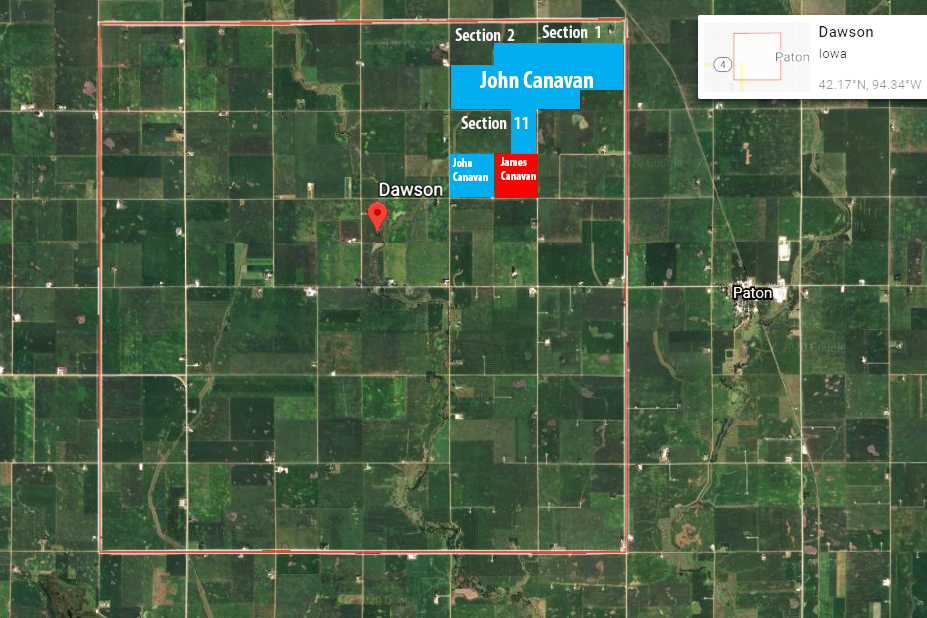
Anthony McNulty was the next one to be interested. He had a store for groceries and liquor near Saint Michael’s Church on the Near North Side in Chicago . He was John ‘s brother-in-law and he persuaded his sister that she should come West too. The grocery store with its flat upstairs had been a kind of refuge for all the Canavans. Mary with her six children rather hated to leave Illinois . Their home was a place the three younger Canavan girls like to visit when they came up on the Illinois Central from Manteno to spend a few days .

